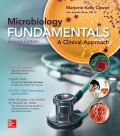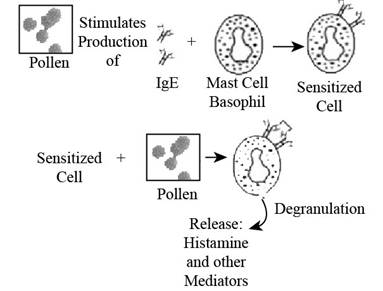
To trace:
The path of pollen grain through sensitization and provocation in type I allergies discussing the role of mast cells, basophils, IgE, and allergic mediators.
Concept introduction:
Type I hypersensitivity or immediate hypersensitivity is triggered by the allergens and the person become “sensitized” by generating large amount of IgE in response to particular allergen. The initial introduction to allergen results in attachment of IgE to cell membrane of basophils and mast cells. The subsequent exposure rapidly release mediators like leukotrienes, and histamine and occurs within seconds. Therefore this reaction is termed as “immediate reaction”.
Explanation of Solution
Pictorial representation: The path of pollen grain through sensitization and provocation in type I allergy is represented as below:

Fig. 1: The path of pollen grain through sensitization and provocation in type I allergy.
All the type I hypersensitivity reactions have a common mechanisms which is immediate onset of allergic reactions against specific antigens. Given below are the roles of mast cells, basophils, IgE, and allergic mediators:
1. IgE: Type I hypersensitivity is triggered by the allergens such as pollen and the person become “sensitized” by generating large amount of IgE in response to particular allergen. The initial introduction to allergen results in attachment of IgE to cell membrane of basophils and mast cells.
2. Mast cells: Mast cells are located in the mucosal and epithelial tissues that line the body surface of all body organs. They are the special tissue cells which are responsible for triggering immune response and allergic reactions in body upon allergen or pollen contact. Allergic reactions caused after exposure of antigens that lead to degranulation of IgE primed mast cells is known as provocative dose.
The dose of allergen which causes release of antimicrobial cytotoxic substances from secretory vesicles known as granules of mast cell involved in immune response is known as degranulation dose.
3. Basophils: Basophils are responsible for allergic and inflammation reactions that target large invading eukaryotic pathogenic species. Basophils are accumulated to the site of allergic reaction when an allergen is encountered in the body.
4. Allergic mediators: The subsequent exposure rapidly release mediators like leukotrienes, prostaglandins and histamine and occurs within seconds. Therefore type I hypersensitivity is termed as “immediate reaction”. Histamine is the fastest acting mediator which helps in elevation of inflammatory symptom, leukotrienes are released from mast cells in response to allergen exposure and cause inflammation response, and prostaglandins are responsible for increased pain sensitivity and vascular permeability in allergic reactions.
The sensitizing dose of pollen triggers IgE production that binds to mast cells. IgE primed mast cell on encountering pollen again (provocative dose), causes binding of allergen with IgE primed on mast cell leading to degranulation. Degranulation of mast cells results in distribution of allergic mediators in blood that cause inflammatory responses.
Want to see more full solutions like this?
Chapter 14 Solutions
EBK MICROBIOLOGY FUNDAMENTALS: A CLINIC
- What did the Cre-lox system used in the Kikuchi et al. 2010 heart regeneration experiment allow researchers to investigate? What was the purpose of the cmlc2 promoter? What is CreER and why was it used in this experiment? If constitutively active Cre was driven by the cmlc2 promoter, rather than an inducible CreER system, what color would you expect new cardiomyocytes in the regenerated area to be no matter what? Why?arrow_forwardWhat kind of organ size regulation is occurring when you graft multiple organs into a mouse and the graft weight stays the same?arrow_forwardWhat is the concept "calories consumed must equal calories burned" in regrads to nutrition?arrow_forward
- You intend to insert patched dominant negative DNA into the left half of the neural tube of a chick. 1) Which side of the neural tube would you put the positive electrode to ensure that the DNA ends up on the left side? 2) What would be the internal (within the embryo) control for this experiment? 3) How can you be sure that the electroporation method itself is not impacting the embryo? 4) What would you do to ensure that the electroporation is working? How can you tell?arrow_forwardDescribe a method to document the diffusion path and gradient of Sonic Hedgehog through the chicken embryo. If modifying the protein, what is one thing you have to consider in regards to maintaining the protein’s function?arrow_forwardThe following table is from Kumar et. al. Highly Selective Dopamine D3 Receptor (DR) Antagonists and Partial Agonists Based on Eticlopride and the D3R Crystal Structure: New Leads for Opioid Dependence Treatment. J. Med Chem 2016.arrow_forward
- The following figure is from Caterina et al. The capsaicin receptor: a heat activated ion channel in the pain pathway. Nature, 1997. Black boxes indicate capsaicin, white circles indicate resinferatoxin. You are a chef in a fancy new science-themed restaurant. You have a recipe that calls for 1 teaspoon of resinferatoxin, but you feel uncomfortable serving foods with "toxins" in them. How much capsaicin could you substitute instead?arrow_forwardWhat protein is necessary for packaging acetylcholine into synaptic vesicles?arrow_forward1. Match each vocabulary term to its best descriptor A. affinity B. efficacy C. inert D. mimic E. how drugs move through body F. how drugs bind Kd Bmax Agonist Antagonist Pharmacokinetics Pharmacodynamicsarrow_forward
 Human Anatomy & Physiology (11th Edition)BiologyISBN:9780134580999Author:Elaine N. Marieb, Katja N. HoehnPublisher:PEARSON
Human Anatomy & Physiology (11th Edition)BiologyISBN:9780134580999Author:Elaine N. Marieb, Katja N. HoehnPublisher:PEARSON Biology 2eBiologyISBN:9781947172517Author:Matthew Douglas, Jung Choi, Mary Ann ClarkPublisher:OpenStax
Biology 2eBiologyISBN:9781947172517Author:Matthew Douglas, Jung Choi, Mary Ann ClarkPublisher:OpenStax Anatomy & PhysiologyBiologyISBN:9781259398629Author:McKinley, Michael P., O'loughlin, Valerie Dean, Bidle, Theresa StouterPublisher:Mcgraw Hill Education,
Anatomy & PhysiologyBiologyISBN:9781259398629Author:McKinley, Michael P., O'loughlin, Valerie Dean, Bidle, Theresa StouterPublisher:Mcgraw Hill Education, Molecular Biology of the Cell (Sixth Edition)BiologyISBN:9780815344322Author:Bruce Alberts, Alexander D. Johnson, Julian Lewis, David Morgan, Martin Raff, Keith Roberts, Peter WalterPublisher:W. W. Norton & Company
Molecular Biology of the Cell (Sixth Edition)BiologyISBN:9780815344322Author:Bruce Alberts, Alexander D. Johnson, Julian Lewis, David Morgan, Martin Raff, Keith Roberts, Peter WalterPublisher:W. W. Norton & Company Laboratory Manual For Human Anatomy & PhysiologyBiologyISBN:9781260159363Author:Martin, Terry R., Prentice-craver, CynthiaPublisher:McGraw-Hill Publishing Co.
Laboratory Manual For Human Anatomy & PhysiologyBiologyISBN:9781260159363Author:Martin, Terry R., Prentice-craver, CynthiaPublisher:McGraw-Hill Publishing Co. Inquiry Into Life (16th Edition)BiologyISBN:9781260231700Author:Sylvia S. Mader, Michael WindelspechtPublisher:McGraw Hill Education
Inquiry Into Life (16th Edition)BiologyISBN:9781260231700Author:Sylvia S. Mader, Michael WindelspechtPublisher:McGraw Hill Education





